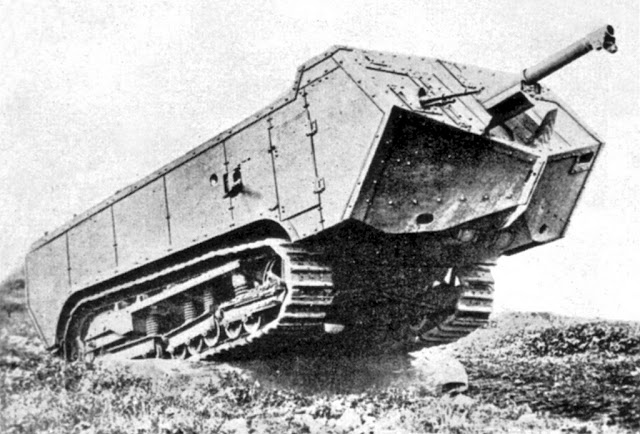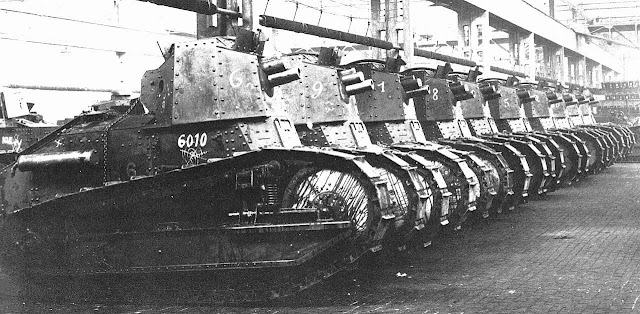Renault FT 17 75BS tank prototype - case report
Brave Poilus!!
***Mes amies…***Today we are going to know a little about what can be considered one of the cars that originated the concept of “aggressive” self-propelled artillery, such as the Soviets’ Su and the Germans’ Stugs… Let’s go back in time, in the muddy and cruel WWI and we meet with the french prototype Renault FT 17 75BS tank.
Colorized picture of Renault FT 17 75BS, prototype of the “artillery tank”
with the 75mm BS gun in the front hull
History:
The artillery is known as “The King of the Battlefield”. And never has this been so exemplified as in the bloody fields of Europe in the WWI… The amount of projectiles that were fired by the countless cannons, mortars and howitzers of all the powers involved in the conflict is unimaginable. And all this artillery barrage convulsed the terrain of the battlefield, And all this artillery barrage convulsed the terrain of the battlefield, transforming the soil of the battlefield into a real challenge to be traversed by men, animals, machines and equipment.
Passchendaele battlefield and craters in which man often drown.
Third Battle of Ypres , July to November 1917, Belgium
At the beginning of the WWI, France (like all other countries) used teams of horses to pull artillery pieces, but with the increase in the calibers (and weight…) of the guns and materials involved, as well as the terrain, which was convulsed by enemy artillery, the animal traction became increasingly complicated, with the animals being easy targets and not supporting the load imposed on them.
The effort and the silent sacrifice…
The breakthrough west of St. Quentin, Aisne, France.
German Artillery drawn by horses advances through
captured British positions on March 26, 1918…
An estimated 8 million horses died during the four years of the WWI.
National Archive / Official German Photograph of WWI
With the advent from the first sketches of mechanization at the front, with the presence of trucks and agricultural tractors adapted to be artillery tractors, there was an improvement in the situation, but the logical solution was to provide the artillery with self-propelled capacity.
This (logical) concept was fought at first, mainly in the minds of old Generals with mentalities rooted in old principles. The massive advances of infantry units against automatic weapons was bloody proof of the obtuseness of ancient tactics in the face of modern weapons…and exacted a terrible price.
Something had to be done…Wheeled vehicles faced great problems in difficult terrain…the few and primitive agricultural tractors with tracks used as artillery tractors proved to be much more useful for the task, being seen as a path to be followed by the military.
In France, the Ministry of Munitions and the French Army High Command have researched almost every possible option for moving artillery using tracked vehicles. The conclusion was that there were only two chassis suitable for the task: the Renault FB Artillery Portee and Schneider CD tractor. The Char Saint-Chamond had an off-road speed of only 2.5 km/h, so it was considered unsuitable for a quick response to the fluidity of the artillery’s tactical situation.
A French Renault FB Artillery Portee
carrying a heavy cannon on the Western front.
Schneider CD tractor in trials
front view
The slow and clumsy char Saint-Chamond tank
With the satisfactory use of the tank, someone soon imagined equipping these vehicles with more powerful weapons. And so, the concept of self-propelled artillery was born.
Renault FT 17 75BS tank prototype:
The Renault FT light gun tank appeared on the battlefields late in 1917, and in significant numbers in 1918, featuring in a 360° rotating turret a machine gun or a low-velocity 37mm cannon. With combat use, it became evident that although the 37mm gun was quite competent to deal with light fortifications, a weapon that delivered greater explosive weight was needed to attack more elaborate fortified positions.
In July 1917, General Estienne, known as “Father of the French Tank Corps”, specified that a vehicle should be developed using the chassis of the new Renault FT-17 light tank, carrying a 75mm Blockhaus Schneider (BS) gun. The 75mm BS gun was originally a short-range demolition gun, which was mounted on the side of the Schneider CA1 tank.
Schneider CA1 at the head of the ranks of French troops.
Notice the 75 mm Blockhaus Schneider (BS) gun in the front right side of the vehicle
Although the 75 mm BS gun had a short effective range with low projectile velocity, its small dimensions, combined with light weight and high rate of fire made it attractive as the main weapon of an FT fire support tank.
75 mm Blockhaus Schneider (BS) gun
3/4 front view
Musée de l’Armée aux Invalides - Paris, France.
75 mm Blockhaus Schneider (BS) gun
3/4 rear view
Musée de l’Armée aux Invalides - Paris, France.
75 mm Blockhaus Schneider (BS) gun
3/4 front view
Musée des Blindes - Saumur, France.
75mm Blockhaus Schneider (BS) gun
caliber 75mm
barrel length (caliber) L/9.5 (rifled)
effective elevation -10° to +30°
traverse 40° (20°+20°)
projectile weight 5.55 Kg
muzzle velocity 200 m/sec
maximum range 2.100m
effective range 600m
weight of gun (firing position) 210 Kg
rate of fire 4-6 rounds/min
In response to the War Ministry’s request, Renault itself built a single prototype, based on the chassis and suspension of the light tank FT-17, but with a strange and improvised look box-shaped upper hull. An interesting detail was the presence of the main armament installed in a low position, in the forward portion of the hull, with limited drift.
Renault FT 17 BS 75 tank prototype
Notice the armament in the tank’s nose…
Trials in France, 1919.
3/4 front right view.
Renault FT 17 BS 75 tank prototype
right side view.
The only two known (this and above) pics (so far) of this model…
Trials in France, 1919.
This design, without a doubt, can be considered the conceptual predecessor of what would be the powerful Russian and German tank destroyers of WW II, like the Su-85 and Stugs III and IV.
During the trials with the prototype, the vehicle proved to be unstable and clumsy to drive, thanks to its high profile, which greatly raised center of gravity. The Commander/driver, moved up and to the middle of the vehicle, had a 360° view, but it was very limited by the small size of the vision slits of the stocky fixed quadrangular cupola.
Renault FT 17 75BS Commander/driver cupola
Notice the small sizes of vision slits
Worse was the position of the two gunners of the 75mm BS gun, which were squeezed into a narrow and awkward battle stations in the front hull. In general, the behavior in field of the prototype did not meet expectations…
The Char de Combat C-2 was a design developed by Peugeot in 1918, to compete again with Renault’s FT17 75BS, using the same main gun, the BS 75mm.
Peugeot Char de Combat C-2
Notice the gun, the same BS 75mm.
3/4 front view
Peugeot Char de Combat C-2
3/4 rear view
Although the concept of using a 75mm cannon was well accepted, but both the Renault FT 17 75BS and the Peugeot C-2 were not accepted for production, the version that was produced (1918) being a much more simplified version FT 75 BS, as it kept the same hull as the FT17 light tank, with the replacement of the 360° rotating turret for a fixed octogonal turret, carrying the approved 75mm BS gun. But this is another history…
Line of brand new Renaults FT 75 BS ,
waiting delivery to combat units.
It is not known the fate of the only prototype built, after its rejection.
Specs:
Renault FT 17 75BS tank prototype
Type self-propelled artillery
Place of origin France
Service history
In service single prototype
Used by France
Designed * 1918 (late)
Specifications
Mass 6.7 tonnes
Length 5.003 mm with tail
4.114 mm without tail
Width 1.714 mm
Height 2.730 mm
Crew 3 (Commander/driver
- 2 gunners)
Armor 8 to 16 mm
Main armament 75mm Blockhaus
Schneider (BS) gun
Engine Renault 4-cyl, 4.5 litre, Gasoline (petrol);
Zenith carburettor,
Magneto ignition
39 hp @ 1500rpm
Power/weight 5 hp/t (3.7 kW/t)
Transmission Sliding gear;
4 forward x 1 reverse.
Main clutch plus two subsidiary clutches
(tracks) for steering
Suspension vertical springs
Fuel capacity 84 litres (about 8 hs)
Operational.range 35 km
Maximum speed 7,5 km/h road
3,5 Km/h off roa




















